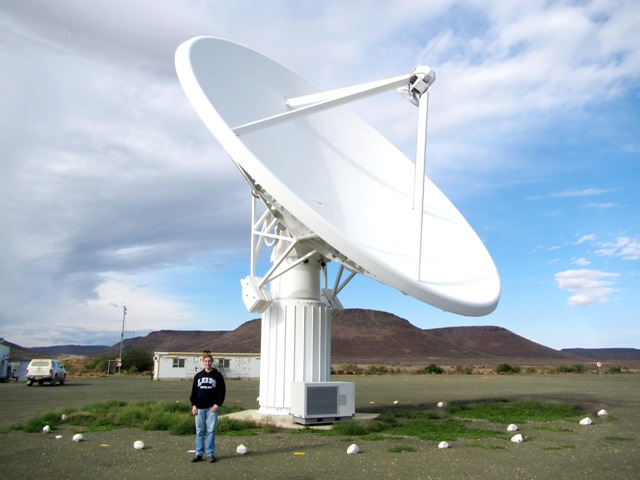Sep 4 2015
A signal stabilisation system that will allow frequency signals and astronomical data to flow along optical fibre cables suspended on poles could save the SKA millions of euros.
 David Gozzard and a the KAT-7 dish at the SKA site in South Africa.
David Gozzard and a the KAT-7 dish at the SKA site in South Africa.
University of Western Australia researchers Sascha Schediwy and David Gozzard, tested a new frequency synchronisation system developed at UWA in South Africa in June as part of the international Signal and Data Transport (SaDT) consortium which is in charge of developing the signal and data network for the international SKA Project.
They were able to show that the optical fibre cables—a critical component in the powerful telescope—can be suspended on standard overhead power poles rather than buried underground.
The SKA will be synchronised to the beat of ultra-stable frequency signals, transmitted from a central atomic clock to each of the hundreds of SKA antennas across an extensive optical fibre network.
However, as the optical fibre length is very sensitive to mechanical, acoustic and thermal changes, an active frequency stabilisation system is required to ensure the thousands of antennas that make up the SKA, remain synchronised.
The current plan is for the fibre cables carrying the synchronisation signals, time signals and astronomical data to be buried to minimise their exposure to the environment. Not surprisingly, overhead cables swing in the breeze a lot more than buried cables.
Burying the cables comes at huge cost, with a trenched route for the three spiral arms of SKA-mid –the telescope to be built in South Africa- expected to cost around 11 million euros.
However, if the SKA’s synchronisation system and time distribution system were to operate just as well on overhead optical fibre, then the fibre cable could simply be suspended on the same poles that support the SKA’s power cables. This would drastically reduce the cost of the fibre reticulation for SKA-mid.
They first deployed a device custom-built at UWA that is able to detect one nanometre length changes in fibre links hundreds of kilometres long, and quickly discovered that the overhead fibre was even more susceptible to environmental impacts than initially anticipated.
The pair found that the SKA-mid’s 150km overhead fibre links would pick up 1000 times more environmental noise than the 2000km buried fibre link across Germany that holds the current record for longest actively stabilised optical fibre link.
Not deterred, Sascha and David adopted the popular South African expression “'n boer maak 'n plan” (we can solve this) and implemented some on-the-fly adjustments to their test plan, before deploying UWA’s SKA frequency synchronisation system on the overhead fibre.
On fibre link distances longer than those required for SKA Phase 1, which corresponds to about 10% of the full SKA-, the overhead system proved reliable at levels well below the most challenging SKA synchronisation requirements, even during wind speeds exceeding the maximum required for normal telescope operation.
These field trials have shown that it will not be necessary to bury the fibre cables along the SKA spiral arms to enable telescope synchronisation. Field trials to confirm that the time signals can also be distributed on overhead fibre are planned for September.
“This is promising work” said Andre Van Es, SaDT project manager at SKA Organisation. “More work needs to be carried out and we look forward to seeing further tests in the next few weeks as part of the consortium’s work”.
This option is one of two considered by the consortium for adoption. Another team in the consortium from Tsinghua University in China is due to test another approach in the coming weeks. The SaDT consortium will then evaluate both options and use this as input for a final design choice.
The ability to transfer stabilised frequency signals on overhead fibre cables could benefit applications relying on accurate and precise timing, where burring fibre is not feasible or cost prohibitive. These applications span a wide range of human endeavours including; fundamental physics, radio astronomy, geodesy, optical spectroscopy, telecommunications, distributed computing, and finance.
This work was supported by the University of Manchester, The University of Western Australia, the International Centre for Radio Astronomy Research, SKA South Africa and Nelson Mandela Metropolitan University.
Sascha and David would also like to specifically thank Bruce Wallace, Jaco Müller, Romeo Gamatham, Tim Gibbon, Roufurd Julie and Franz Schlagenhaufer for their assistance.